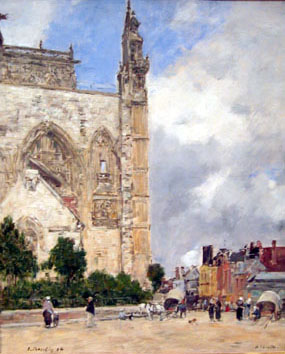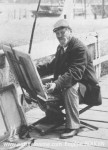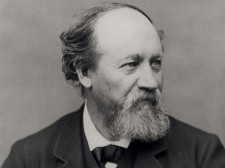
Eugene Boudin
French, 1824-1898
Abbeville: Église de Saint-Vulfran, 1894
oil on panel
18 x 14 1/2 in.
SBMA, Gift of Mrs. L. H. Kirkpatrick
1973.48

Photo of Boudin painting en plein air
“Everything that is painted directly and on the spot has always a strength, a power, a vivacity of touch which one cannot recover in the studio... three strokes of a brush in front of nature are worth more than two days of work at the easel. “
Eugene Boudin
RESEARCH PAPER
Eugene Boudin painted this work in l894 as part of a series, this being the only one painted of the back of the church. Boudin was a prolific artist (nearly 4000 paintings) known for his marine scenes and skies. He was a self-taught artist, born to a long line of sailors and fishermen, and grew up with an intimate knowledge of the sea on the northwest coast of France. He had no rival in terms of illustrating harbor views during his lifetime and was a natural at capturing the atmosphere of the everchanging French skies. As is seen in this painting, he devoted significant space to the sky, often ¾ of the canvas. Corot referred to him as "king of the skies".
This painting was completed towards the end of Boudin's life when he was 70 years old (he lived to be 74). After having gone through a particularly difficult time in his life (which included the death of his beloved wife) he was looking for new challenges. Public recognition came late in his life but he did not want to rest on his laurels. Many collectors feel that his later paintings are among his best. Boudin had a friendship with Monet (who was 15 years younger) and helped direct Monet's development as an artist by encouraging him to come to Normandy and paint outdoors. "Monet came and understood...he said it was just like a curtain had opened in front of his eyes and he understood what his life was about and what painting was about "(1). By the time of Boudin's painting of the church in Abbeville (an unusual subject for a self-described atheist), Monet had had great success with his Rouen cathedral series. Perhaps at this point Monet was influencing Boudin in his search for new challenges.
The Church of Saint Vulfran was named after St. Vulfran who, as a patron saint, protects from the dangers of the sea (interesting coincidence in that Boudin had focused on painting water his entire career). It is located on the Somme River, twelve miles from the English Channel. The church was constructed during the l5th, l6th, and l7th centuries and is an example of late Gothic (Flamboyant) style architecture. Often times the construction of these churches took so long that the original plans were not the ultimate result. A distinctive characteristic is their height and verticality; these were the skyscrapers of the day. The architectural concept was to convey the great glory of God. Boudin's paintings capture the reality of the place; he invented nothing, arranged nothing (2).
The composition of this painting consists of a low horizon line, less than one-third of the canvas with the size of the indistinct figures in the foreground miniscule in contrast to the church. The church occupies almost the entire canvas from the mid-point to the left edge and top of the canvas. There is so much detail on the building (typical of Flamboyant Gothic) that the viewer may not be aware that one is looking at the back. The size alone is awe inspiring and dominates the piece. The town with all its bustling activity recedes on the right side of the canvas and is overshadowed by one of Boudin's wondrous skies which silhouettes the church. The tones of the clouds complement those of the church and help balance the painting. Although Boudin was searching for new challenges his signature sky remains in this new type of landscape for him.
Boudin worked outdoors and preferred working on smaller canvases. He worked quickly often changing the brush between hands while holding another brush in his mouth (3). His palette consistently worked off the color gray (4). This painting is a good example of the color range he stayed with throughout his life. If he did add color it was usually a little patch of red. Boudin was so concerned with the effect of light that oftentimes he not only dated his work in the margins but also included the hour!
Boudin is seen as a "transition" painter between the Barbizon style of Corot and that of the Impressionist Monet. Although self-taught, Corot influenced his style and development. Boudin was a well-respected painter among the older living artists of his time.
He was a link to the future. As he became older he was less concerned with subject matter and, though not considered an impressionist, he was more concerned with light. As Monet commented, "If I have become a painter...I owe it to Eugene Boudin."(5).
Prepared for the SBMA Docent Council by Cynthia Schoustra, Ph.D. April 4, 2012
(l) NPR, July 1, 2010.
(2) Aubrey, G. Page 173.
(3) Ibid. Page l82.
(4) Ibid. Page 174.
(5) Ibid. Page 27.
References
Aubry, G. (1968) Eugene Boudin . Neuchatel, Switzerland. New York Graphic Society Ltd.
Sutton, P. (l99l) Boudin-Impressionist Marine Paintings . Salem, MA. Peabody Museum of
Salem.
Young, M. and Paris, K. (l976) Louis Eugene Boudin: Precursor of Impressionism . Santa
Barbara, CA. Santa Barbara Museum of Art.
http://www.NPR July 1, 2010/Eugene Boudin: The Man Who Inspired Monet. Susan
Stamberg
http://www. Wikipedia/Gothic Architecture

Undated photo of Boudin.

Re Boudin’s influence on Monet:
Recently in Paris, I saw two oil paintings of the same church by Boudin, dated 1884 and 188? (curator can’t read the last number). One showed the church at night. These paintings were done a decade before the painting at SBMA. The museum wall panel discusses the great influence that Boudin had on the younger Monet, especially re the desire to capture ephemeral light effects, and the idea of painting a “series.”
Here is my translation of the French wall text in the museum:
Monet wrote to his biographer G. Geoffroy in May 1920, “As far as concerns my relations with ‘the king of skies,’ I think I’ve already told you, I consider Eugene Boudin as my master … I have come to be fascinated by his rapid sketches, daughters of what I would call “instantaneity.” I owe everything to Boudin and am grateful to him for my success.”
This confidence given to Boudin at the end of Monet’s life shows the determinate role of Boudin, who noted, in the young painter of 19 years, a promising talent and encouraged him in proposing to him that he come to paint with him according to nature. The relationship is first founded on an aesthetic heritage centered on a quest for light. In 1887, Boudin resumed the heart of his quest. “Light above all! To search out its rays, its lightning flashes, to condense it, to pursue it in its warmth.”
It is this ephemeral meeting between a scene, natural or urban, and the unique light of a certain hour or a certain season which is at the heart of the thought process of Boudin. This is precisely the heritage claimed by Monet.
During several decades, pushed by the demands of his marketers, and by his taste for atmospheric effects, Boudin chose to create several paintings taken from the same point of view, but at different hours. Thus he initiated the idea, quite musical, of “variations on a theme,” the church at Abbeville seen at night, the beach at Deauville at high tide and at low tide. This was for him just something done intuitively, spontaneously. But it is precisely this aesthetic intuition which Monet claimed, systematized and developed, a few years later, with his principal of “series.” Monet thus started his first studies at the Cathedral of Rouen in choosing a point of view very close to that of Boudin, as Boudin had painted the church at Abbeville.